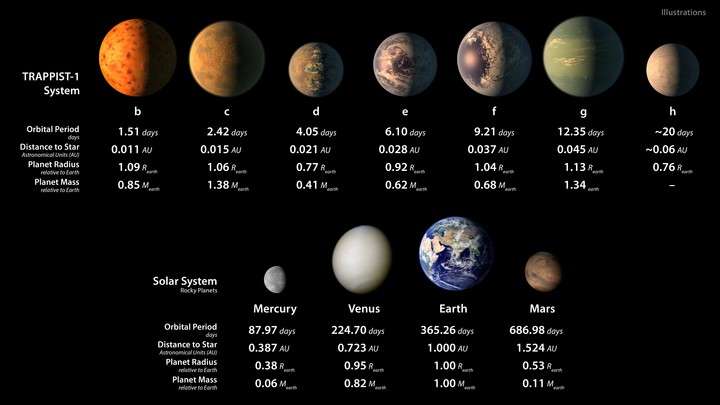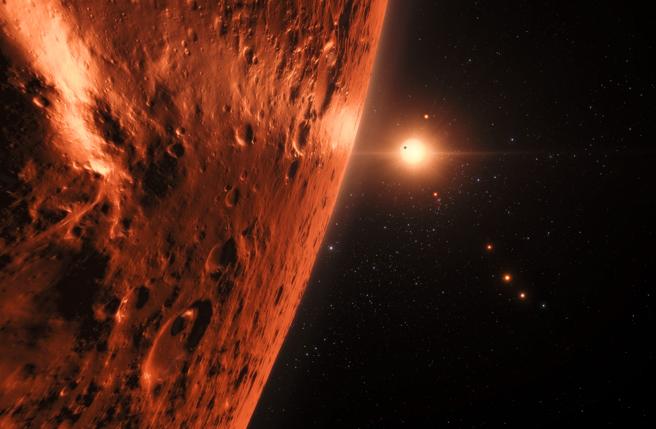Last Updated on March 9, 2021 by Editor Futurescope
When astronomers see tiny stars twinkling through their telescopes, they will now know with certainty that around some of them there are worlds not very different from ours. The discovery of planets began in the 90s and since then about 3,500 of these planets have been discovered. On Wednesday, a Dutch-led international research team, using telescopes both on Earth and in space, announced the discovery of a solar system 40 light-years away with seven exoplanets the size of ours rotating around a small star.
Those faint stars, or “ultra-cold dwarf stars,” have a positive side. They are weak, so the planets that pass between them and us will block a greater percentage of light than they could with much bigger and brighter stars. That makes them about 80 percent easier to detect than if they orbit around a star the size of the sun.
An international team of astronomers has discovered a new solar system with seven Earth-sized planets. It is about 40 light years from us, around a faint and cold star of a type known as “red dwarfs.” In the Milky Way, this class of stars are much more abundant than stars like the Sun and have recently become the favorite place to look for Earth-twins that could harbor life, according to researchers and NASA officials in wheel of the press. “The question now is not whether we will find a planet like the Earth, but when,” they have assured.
The new solar system orbits around Trappist-1, a star the size of Jupiter located in the constellation of Aquarius. Last year, an international team of astronomers found three planets orbiting around this star, with only 8% of the Sun’s mass. In a new study published today in the journal Nature, the same team confirms the existence of those stars. Three worlds and announces another four. They are all similar in size to Earth, but are much closer to their weak star, which would allow them to harbor liquid water, an essential condition for life. This is the solar system with more exoplanets the size of the Earth and could contain water that has been found to date, according to a statement from the European Southern Observatory (ESO).


The first planets outside our solar system, known as exoplanets, were discovered in the mid-1990s. From the earliest discoveries – planets the size of Jupiter orbiting stars closer to what Mercury revolves around the Sun – astronomers have had which rule out the assumptions of what a solar system looks like.
Since then, about 3,500 exoplanets have been discovered. If there are about 200,000 million stars in the Milky Way galaxy, and each of them has at least one planet, that’s a billion-fold possibility of Earth-like planets.
Exoplanets are planets that orbit around a star other than the Sun. They are therefore outside the solar system.
With the advancement of technology, research on exoplanets began during the twentieth century: it seeks life and living conditions for humans. The first was found in 1992 and since then there have been several discoveries.
Although they had been suspected for some time, existing detection systems prevented them from being found for decades. It was not until 1992 that planets with a terrestrial-like mass were orbited around a pulsar star were discovered. This discovery is due to the astronomers Michel Mayor and Didier Queloz.
The official NASA site reported 3,449 confirmed exoplanets and 4,696 under analysis today.
But days ago the US space agency announced the discovery of 7 more, which could have water. This reinforces an impressive discovery dating back to 2015, the exoplanets Kepler-452b, which offers a habitat similar to ours.
The closest exoplanet to our planet is Next Bb, an enigmatic Earth-sized world: it is 4 light years away (four years traveling at the speed of light). As a point of comparison, the entire Solar System has a maximum length of 20 light hours.
The exoplanets discovered so far are huge gaseous masses, similar to the planet Jupiter. Its orbital periods are very short and are very close to its star. The fact that so far only large planets have been discovered responds, according to experts, to the limitations of the detection systems. It has not been until now that they have found planets with masses similar to the Earth.
Discovery of exoplanets: Can there be life in Trappist-1?
Seven terrestrial planets orbiting around a cool and quiet sun, at suitable distances so that there is liquid water in them. The panorama cannot be more optimistic for Trappist-1 (it is always better that name than its official name of 2MASS J23062928-0502285) can shelter the first sign of life outside our planet.
But things may not be so favorable. First, the distance of those planets to their star is very small. Of course, much lower than the one that separates us from the Sun. Suffice it to say that one year of the most interior planet lasts only one earth day.
Trappist-1 is a red star much colder than the Sun. Therefore, the closeness of its planets ensures a temperature tolerable and compatible with the existence of water in liquid state. That is good. But the same closeness makes them more likely to be blocked by tidal forces, always presenting the same face to their star, as does the Moon with the Earth. Or like most satellites of Jupiter or Saturn. That’s bad.
And it is bad because it would entail tremendous temperature contrasts: One face of the planet always illuminated and warm, while the other would be in perpetual darkness. The only habitable zone would be the intermediate one, a more or less narrow strip between night and day. Although it would not be pleasant to live there either because the thermal differences between one hemisphere and another would probably cause hurricane winds.
That, not to mention that Trappist-1, like most red dwarf stars emit from time to time intense flashes of radiation that would reach fully to planets so close. It would be necessary for these to be protected by a magnetic field and a moderately dense atmosphere, such as Earth.
When the new telescopes (space and also on land) come into service, it will be possible to try to analyze the composition of these atmospheres. The mere fact that they exist would be good news. And if traces of methane or oxygen are detected in them, even in minute quantities, the arguments for life would be greatly reinforced. Not because tiny traces of oxygen were breathable but because their mere presence would mean that something is producing it.
In February and March 2016, astronomers used NASA’s Spitzer Space Telescope to pick up the tiny fluctuations in starlight that occur when planets pass in front of their star. Terrestrial telescopes in Chile, South Africa, Morocco, the USA and the island of La Palma in the Canaries also directed their lenses to Trappist-1 between May and September. The observations confirm the existence of six planets, Trappist-1 b, c, d, e, f and g, according to their decreasing proximity to the star, and suggest the existence of a seventh, h, not yet confirmed. The six confirmed planets appear to be rocky, such as Earth, Mars, Venus and Mercury, though some may be much less dense. Trappist-1 and its worlds closely resemble Jupiter and its icy moons Io, Europa, Ganymede and Callisto, some also candidates to harbor life.


“It’s an amazing planetary system, not only because there are so many but because their size is surprisingly similar to the Earth,” says Michaël Gillon, a researcher at the University of Liege, Belgium and lead author of the study. “The question of whether we are alone in the universe will be solved in the coming decades,” said Thomas Zurbuchen, a NASA researcher, during the press conference. It will not be traveling, or at least for now: to get there with the current technology, we would need about 300,000 years.
The planet closest to its sun takes one day to complete an orbit and the farthest one, 12. The first three are too close to the star, which probably have too scorching climates so that water does not evaporate from its surface, According to the climate models used by astronomers. It is probable that, with a size more similar to that of Venus or Mars, is a world frozen by its distance from the star. The three remaining planets are within the so-called “habitable zone” and can harbor oceans, according to ESO.
The most important thing about this discovery is that it allows one to observe for the first time the atmosphere of one of these planets, explains Guillem Anglada-Escudé, a Barcelona astronomer who works at Queen Mary University in London. It is a scientific achievement that is worth a Nobel and one of the fundamental steps in the search for life outside the Solar System. Last year, Anglada-Escudé discovered the Earth-sized exoplanet closest to Earth, four light-years away.
Observe the atmosphere
This world also orbits a red dwarf, Near Centauri, and may be covered by a great ocean. It remains to be seen whether it has atmosphere, an almost essential condition for life, and whether it is observable from Earth. In the planets of Trappist-1 “it is possible that the Hubble space telescope can analyze if there is atmosphere in one of these planets and it is quite probable that the James Webb Space Telescope, that will be launched next year, can confirm it”, explains the astronomer.
Although they cannot be seen with the naked eye from Earth, three out of four stars in our galaxy are red dwarfs, so it is possible that discoveries such as today become the norm. The name of the star responds to the acronym of Small Telescope for Planets in Transit and Planetesimals (Trappist), a system of two robotic observatories of the University of Liege (Belgium) that is tracking the 60 cold dwarf stars closest to Earth in search of the transit of habitable planets. According to Ignas Snellen, of the University of Leiden (The Netherlands), for every planet that can be detected by this method “there are between 20 and 100 times more planets” in a commentary on the original article that is published In Nature.
So this finding should be a reminder to Earthlings that there are no objective reasons to feel special. “Finding seven planets in a sample [of analyzed stars] so small suggests that the Solar System with its four rocky planets may not be anything out of the ordinary,” writes the researcher in a commentary on the original article in Nature. Can these planets accommodate life? “One thing is for sure: in a few billion years, when the Sun has exhausted its fuel and the Solar System ceases to exist, Trappist-1 will remain a star in its infancy. It consumes hydrogen so slowly that it will remain alive for 10 billion years, 700 times more than the total age of the Universe, and possibly enough time for life to evolve, “he concludes.
When our solar system was the only one we knew, it was easy to fantasize on television, in the movies and in our imagination, that other stars had a whole range of planets just like ours. What reveals what is now revealed is that the assumption, while doubtless erroneous, is not as erroneous as we thought.
The size of the exoplanet sample is still too small. There are several thousand documented planets, compared to the many hundreds of billions of possibilities. The good news is that the discovery of Trappist-1 has a huge influence on the odds of finding Earth-sized planets elsewhere. If there are seven orbiting a nearby sun, one can assume there are many beyond there that scientists have not yet been able to detect.







